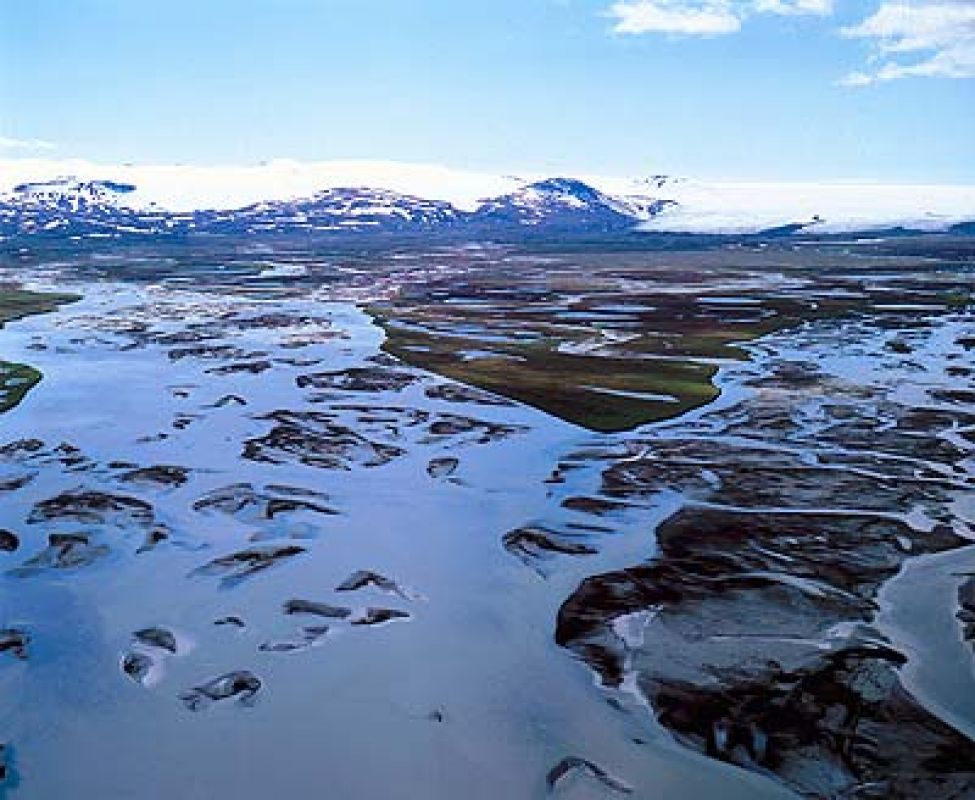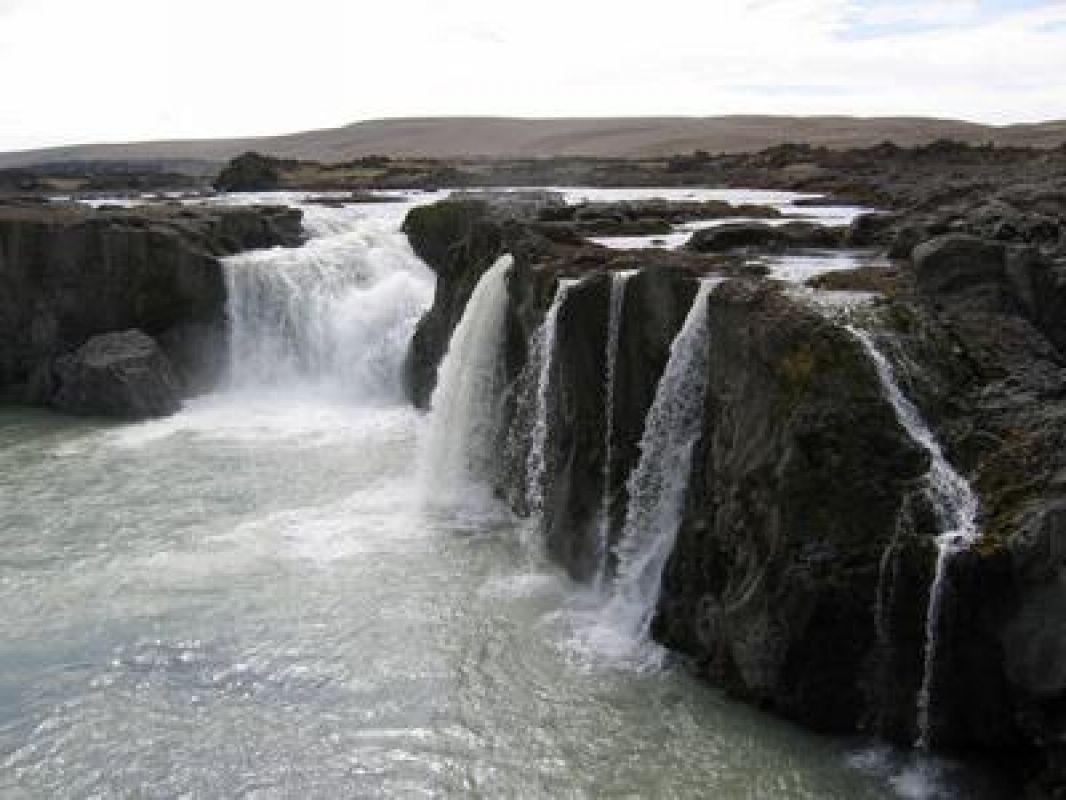Background
Oct 08 2007
2 Comments
ALCOA, Bauxite, Century Aluminum, Climate Change, Corruption, Dams, Democracy deficit, Ecology, India, Mining, Pollution, Repression, Rio Tinto Alcan
An IPS/SEEN/TNI report, 2001
This important and lengthy report from the Washington based Sustainable Energy and Economy Network is highly informative about the operational structure of the aluminum industry and the resulting impacts on human rights and the environment.
Read More
Pages: 1 2 3 4 5 6 7 8 9 10 11 12 13 14 15 16 17 18 19 20 21 22 23 24 25
Sep 07 2007
Amazon, Climate Change, Dams, Ecology, Greenwash, Guðmundur Páll Ólafsson, hydropower, Jaap Krater, Kárahnjúkar, Pollution, Þjórsá
Glacial rivers are not only the lifeblood of Iceland, but also of the whole planet.
River water contains sediment in suspension and various substances in solution; glacial rivers, especially, carry a large amount of sediment which increases as the atmosphere grows warmer.

Rivers of Life
Glacial rivers carry the sediment out to sea, where it takes on a new and important role in binding the greenhouse gas carbon dioxide (CO2) with calcium (Ca) and converting it into calcite and other carbonate minerals, immensely important in the ocean ecosystems of the world. Thus glacial rivers reduce pollution on Earth. This effect is greatest in recently formed volcanic territory such as Iceland, and the binding effect increases with rising atmospheric temperature.
Glacial rivers bind this gas which, along with some other gases, causes global warming and threatens the future of life of Earth.
When a glacial river is harnessed to generate electricity, this important function, and the binding of the greenhouse gas CO2, is diminished. What they generate is not GREEN ENERGY, as the advocates of hydro-power plants and heavy industry maintain, but BLACK ENERGY.
Dams and reservoirs hinder the function of glacial sediment in the oceans, and hence hydro-electric power plants that harness glacial rivers are far more harmful than has hitherto been believed. Read More
Sep 03 2007
Actions, ALCOA, Amazon, Arms Industry, Century Aluminum, Cultural, Ecology, Greenwash, Icelandic Alloys/ELKEM, India, Jaap Krater, Landsvirkjun, Norsk Hydro, Pollution, Repression, Reykjavik Energy, Saving Iceland, South Africa, Trinidad & Tobago
 Jaap Krater
Jaap Krater
Earth First Journal
3 August, 2007
Summer of Resistance in Iceland – an overview
This year, Iceland saw its third Summer of direct action against heavy industry and large dams. In a much-disputed master plan, all the glacial rivers and geothermal potential of Europe’s largest wilderness would be harnessed for aluminum production (see EF!J May-June 2006). Activists from around the world have gathered to protect Europe’s largest remaining wilderness and oppose aluminum corporations.
Read More
Sep 02 2007
1 Comment
ALCOA, Alterra Power/Magma Energy, Century Aluminum, Climate Change, Ecology, EIA, Geothermal Energy, Greenwash, Helguvík, Hengill, HRV/Hönnun, Jaap Krater, Miriam Rose, Norsk Hydro, Pollution, Reykjavik Energy, Rio Tinto Alcan, Samarendra Das, Saving Iceland
 By Jaap Krater, Miriam Rose and Mark Anslow, The Ecologist, October 2007.
By Jaap Krater, Miriam Rose and Mark Anslow, The Ecologist, October 2007.
The gates of a geothermal power station are not where you would expect to find environmental activists. But the morning of 26th July 2007 saw the access road to Hellisheidi power station in Hengill, South-West Iceland, blockaded by a group of protestors from the campaign group ‘Saving Iceland’. After a brief demonstration, nine activists were arrested and several now face legal action.
Geothermal power in Iceland is big business. Just five plants generate 3 TWh a year – more than the annual output from all the UK’s wind turbines combined (Orkustofnun 2005; BERR 2006). Geothermal power also provides at least 85 per cent of Iceland’s homes with heat and hot water. This abundance of cheap, largely CO2-free energy has attracted energy-hungry industries to the country like sharks to a carcass. Of these, by far the most energy intensive is the aluminium industry (Krater 2007; Saving Iceland 2007).
Read More
Aug 19 2007
1 Comment
ALCOA, Bakki, Climate Change, Greenwash, Krafla and Þeistareykir, Pollution, Skagafjörður, Skjálfandafljót, Þjórsárver

Is the Energy on the Doorstep?
By Dr. Ragnhildur Sigurðardóttur
Many things have been said and written about plans for ALCOA´s aluminium plant at Bakki near Húsavík. One after another, important men have praised the idea and by now the only political parties not supporting it are the Iceland Movement and the Left Green party.
The propaganda of the supporters follows these lines: “utilise the national energy potential,” “the people of Húsavík have a right to an aluminium plant,” “the plant will only use energy drawn from the land nearby Húsavík, “damming of Skjálfandafljót and Jökulsá á Fjöllum is nothing but environmental propaganda”, “Geothermal energy has a low environmental impact”, “preparation work has been exceptionally well done.”
But how much truth do those slogans contain? Is there something more that needs to be looked into? Are the people of Húsavík, politicians included pushing the issues forward without really having looked at all the facts? Read More
Aug 18 2007
4 Comments
ALCOA, Amazon, Australia, Climate Change, Cultural, Dams, Ecology, Economics, Greenwash, Guðmundur Páll Ólafsson, hydropower, India, Jaap Krater, Pollution
Trouw (daily), Netherlands, 21 January 2007
Large dams have dramatic consequences. Ecosystems are destroyed and numerous people are made homeless, often without adequate resettlement. But it is yet little known that large-scale hydro-electricity is a major contributor to global warming. The reservoirs could, despite their clean image, be even more devastating for our climate than fossil fuel plants.

A few years ago, I spent a month in the valley of the Narmada River, to support tribal activists who have been resisting the Sardar Sarovar dam in central India for decades. These indigenous inhabitants, or adivasis, are desperate. In their struggle, inspired by Gandhi, they attempt to drown themselves when their villages are flooded. Death seems preferable to being forced to move from their valley to tin houses on infertile, barren soil. If they’re lucky, they can live on land that nobody else wants, the only available in the densely populated India. This forced resettlement, made necessary by ´progress´, is not unsimilar to what befell American Indians or the Aborigines in Australia. The consequences of mega hydro: cultures die and alcoholism, depression and violence remains.
Read More
Aug 10 2007
1 Comment
ALCOA, Ecology, Economics, Greenwash, Guðmundur Páll Ólafsson, Landsvirkjun, Pollution, Repression
“The hurt many of us feel towards the developments in eastern Iceland is so great that we will never accept another aluminum smelter to be built in Iceland. We would not be surprised if the environmental NGO’s and grass root organizations would consider the proposed developments in Northern Iceland to be a serious provocation on the behalf of Alcoa.”
Read More
Jul 24 2007
9 Comments
Actions, Africa, Arms Industry, Jaap Krater, Landsvirkjun, Rio Tinto Alcan, Saving Iceland, South Africa
Landsvirkjun Involved in Coal & Nuclear Powered RioTinto-Alcan Smelter in Africa
 HAFNAFJORDUR – Saving Iceland has closed access to RioTinto’s Straumsvik smelter in South-West Iceland. About 20 protestors have locked their arms in metal tubes and climbed onto cranes on the smelter site. Saving Iceland opposes plans for a new RioTinto-Alcan smelter in Keilisnes or Thorlakshöfn, expansion of the existing smelter, and a new coal and nuclear powered smelter in South Africa.
HAFNAFJORDUR – Saving Iceland has closed access to RioTinto’s Straumsvik smelter in South-West Iceland. About 20 protestors have locked their arms in metal tubes and climbed onto cranes on the smelter site. Saving Iceland opposes plans for a new RioTinto-Alcan smelter in Keilisnes or Thorlakshöfn, expansion of the existing smelter, and a new coal and nuclear powered smelter in South Africa.
“Protests against Alcan have been successful. Of course the people of Hafnafjordur have stopped the expansion of Straumsvik and recently, in Kaskipur, Northeast India, Alcan had to give up it’s participation in a bauxite mine because of protests against their human rights violations and environmental devestation. Alcan has been accused of cultural genocide in Kashipur, 1 because mining and dams have already displaced 150.000 mainly tribal people there 2. Norsk Hydro left the project when police tortured and opened fire on protestors, and then Alcan moved in,” says Saving Iceland’s Jaap Krater.
Read More
Jul 20 2007
Congo, Ecology, South Africa

Fishermen on the Congo at Kisangani. Campaigners fear any dam on the 2,600-mile Congo, aka ‘the river that swallows all rivers’, may harm fishermen such as these at Kisangani. Photograph: Schalk Van Zuydam/AP
By Jeevan Vasagar , The Guardian, February 25, 2005
One of Africa’s biggest electricity companies yesterday unveiled plans to build the world’s biggest hydro-electricity plant on a stretch of the Congo River, harnessing enough power for the whole continent.
The proposed plant at the Inga Rapids, near the river’s mouth in the western Democratic Republic of Congo, would cost $50bn (£26bn) and could generate some 40,000MW, twice the power of China’s Three Gorges dam. Read More
